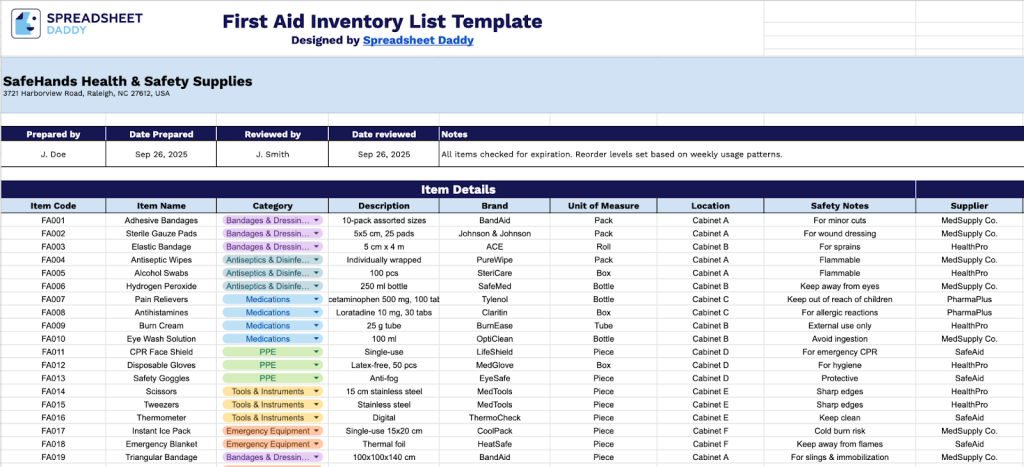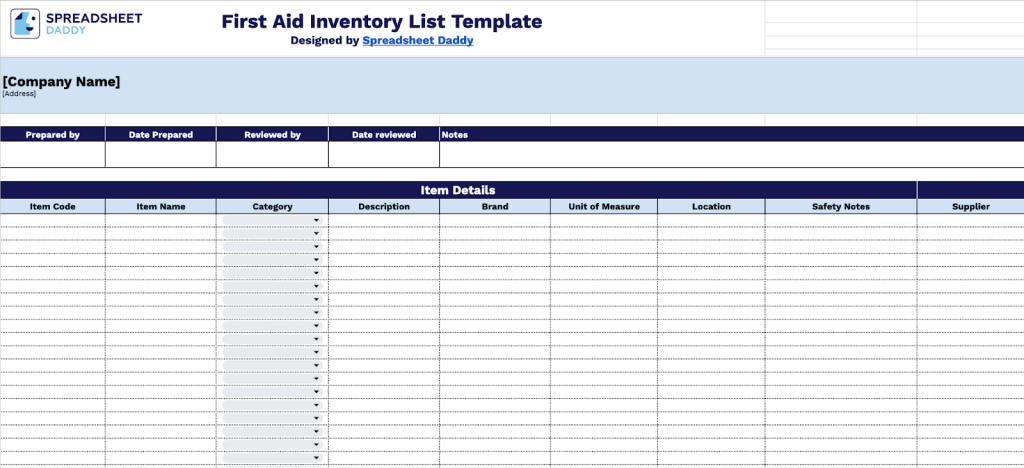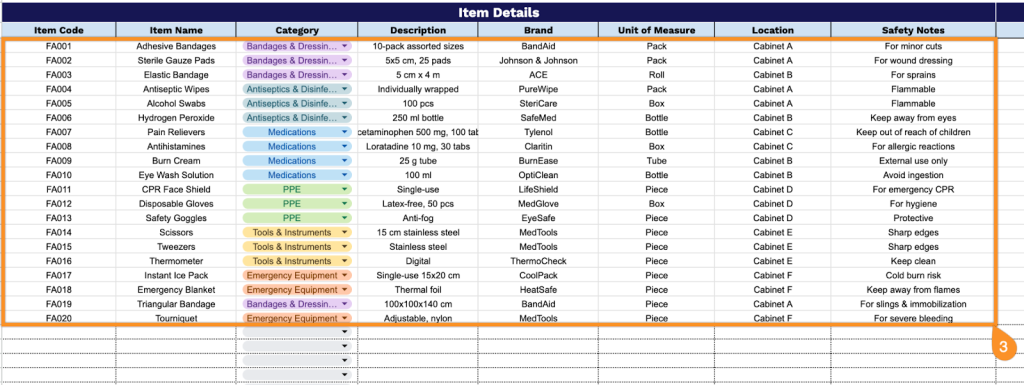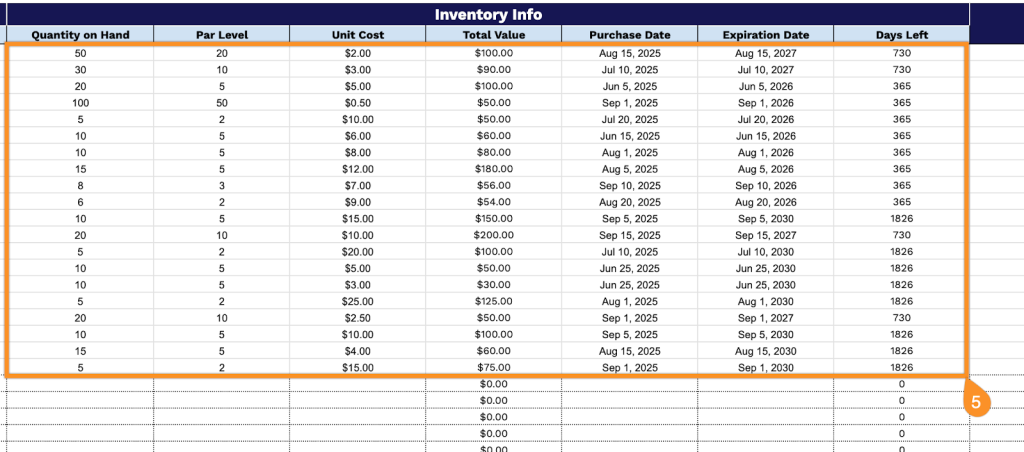A well-stocked first aid kit can make all the difference in an emergency, but only if you know what’s inside and when supplies need replenishing.
Whether you’re managing first aid kits for your home, workplace, school, or outdoor adventures, keeping an accurate inventory ensures you’re never caught unprepared.
Our free first aid inventory spreadsheet template makes it simple to track bandages, medications, tools, and supplies at a glance.
Available in Google Sheets, Excel, and PDF formats, this ready-to-use template helps you maintain compliance with safety regulations, track expiration dates, and quickly identify items that need restocking.
Download your free template today and eliminate the guesswork from first aid preparedness.
Quick Jump
ToggleWhat Is a First Aid Inventory Spreadsheet?

A First Aid Inventory Spreadsheet is a structured document used to track and manage the contents of first aid kits and medical supplies in a workplace, facility, or organization.
This tool helps safety coordinators and medical personnel maintain compliance with regulations, prevent shortages during emergencies, and efficiently manage restocking schedules.
Download Spreadsheet Daddy’s Free First Aid Inventory Management Spreadsheet

Our First Aid Inventory List Template helps you track and manage your medical supplies effectively.
You can effortlessly tailor it by adding or deleting columns to suit your requirements. This template helps you easily keep track of inventory and monitor expiration dates, ensuring your first aid supplies are always prepared when needed.
What’s included
- Complete supply documentation: Capture complete details for every first aid supply, including Item Code, Item Name, Category, Description, Brand, Unit of Measure, Location, and Safety Notes. This ensures complete visibility of your medical inventory across all storage locations.
- Vendor information at your fingertips: Track vendor contact details and lead times directly in the template. This helps streamline ordering processes and maintain consistent supplier relationships without requiring additional documentation systems.
- Stock level tracking and cost analysis: Monitor stock levels with Quantity on Hand and Par Level fields, along with Unit Cost and Total Value calculations. This prevents shortages, triggers timely reorders, and provides clear insight into your inventory investment.
- Expiration date management: Record the Purchase Date and Expiration Date for each item, along with a ‘Days Left’ calculator that flags supplies approaching expiration. This ensures compliance with safety regulations and prevents the use of outdated medical materials.
- Team accountability and documentation: Built-in header fields for Company Name, Address, Prepared by, Date Prepared, Reviewed by, and Date Reviewed, plus a dedicated Notes section for special instructions, audit trails, and incident documentation related to inventory management.
How to Use Our First Aid Inventory Spreadsheet Template
1. Customize this template by duplicating it in Google Sheets or exporting it to Excel or PDF format.
2. Fill in the company name and physical address, then add stock coordinator data and finalization date. Document the manager’s name, along with the inspection date, and use the Notes section for supplementary details.

3. Complete the Item Details section by entering all essential medical supply information:
- Item Code: Enter the unique identifier or product code assigned to each first aid item for inventory tracking.
- Item Name: Specify the complete product name and description of the medical supply.
- Category: Select the appropriate classification (Consumables, Instruments, PPE, Medications, etc.).
- Description: Provide detailed information about the item’s purpose, specifications, and intended use.
- Brand: Include the manufacturer or brand name associated with the medical supply.
- Unit of Measure: Record how the item is counted or dispensed (individual units, boxes, bottles, packages, etc.).
- Location: Document the specific storage area or cabinet where the item is kept for quick access during emergencies.
- Safety Notes: Include critical information such as handling precautions, storage requirements, allergen warnings, or usage restrictions.

4. Document supplier relationships in the Supplier Info section for vendor management:
- Supplier: Enter the name of the vendor or distributor providing the first aid supplies.
- Lead Time: Record the expected delivery timeframe from order placement to receipt of supplies.
- Contact Info: Include phone numbers, email addresses, and key contact persons for emergency reordering.

5. Track stock levels and financial data in the Inventory Info section for compliance and budgeting:
- Quantity on Hand: Document the current number of units available in your first aid inventory.
- Par Level: Establish the minimum quantity that should be maintained to ensure adequate emergency preparedness and response.
- Unit Cost: Enter the price paid to acquire each unit for budget tracking and replacement cost calculations.
- Total Value: The template automatically calculates the overall monetary value of the current stock for financial reporting purposes.
- Purchase Date: Record when the item was acquired to monitor inventory age and rotation schedules.
- Expiration Date: Document the manufacturer’s expiration date to ensure supplies remain safe and effective for use.
- Days Left: The template automatically tracks the remaining time until expiration, prioritizing the usage and replacement of time-sensitive items.

6. Document key observations and additional context in the Notes field to improve your inventory management and ensure regulatory compliance with first aid requirements.
